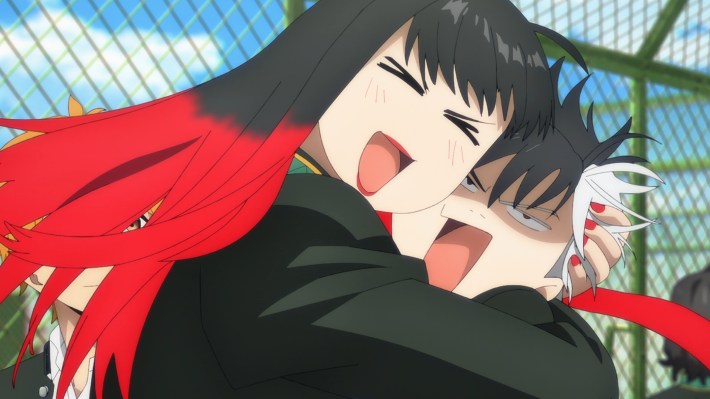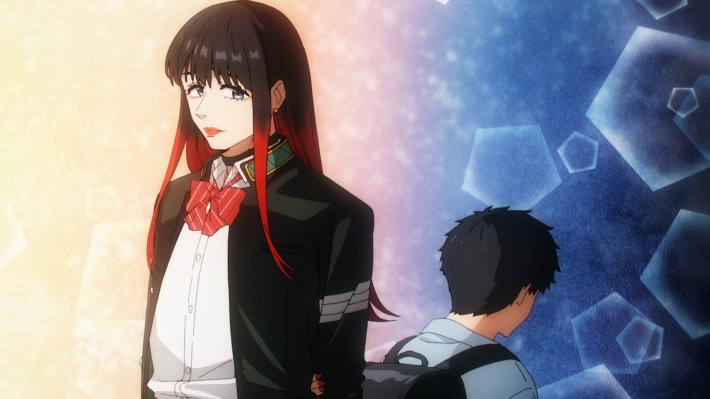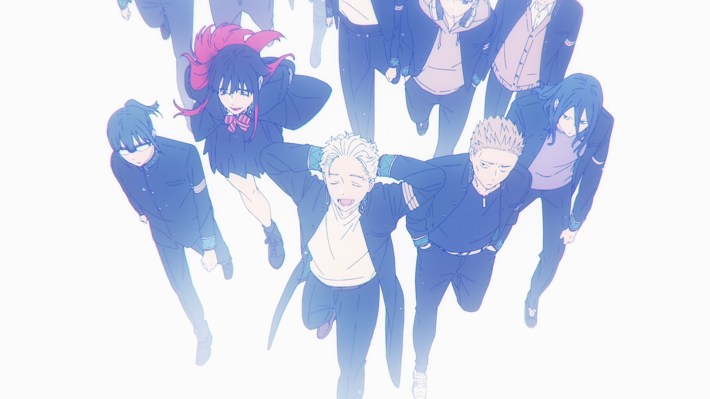I have a love/hate relationship with shonen anime. On the one hand, I love the fights and the action. On the other hand, I feel like so much focus on fights and action can breed toxic ideas about masculinity, with few shows examining what it really means to be “the strongest” beyond physical strength and power scaling debates. Wind Breaker restored my faith in the genre by showing that strength can be something more than just physical prowess.
Wind Breaker, created by Satoru Nii and animated by CloverWorks, is basically what would happen if the Yakuza games were made into an anime. The series follows a group of rival gangs whose diverse archetypes of delinquent boys beef over turf, where the only adults appear to be the local business owners in the fictional Tokyo shopping district of Makochi.
Wind Breaker’s story follows the new kid on the block, Haruka Sakura, who quickly gets involved in the gangsta life after enrolling in Furin High School and joining up with its titular gang, Bofurin. Each high school gang has its captains, lieutenants, and foot soldiers, but rather than shake down neighborhoods for money, Bofurin acts as its town’s protectors from rival gangs running amok — basically how Kiryu Kazuma fashions himself as the stalwart protector of Kamurocho. The show’s secret sauce isn’t its action, though the action is incredible. It's how the show redefines masculinity through brotherhood and acceptance.
While the “power of friendship” anime trope has often been reduced to the usually half-baked and understated emotional fuel for fights, Wind Breaker flips the script. Instead of feeling obligatory or stale, its portrayal of brotherhood is earnest, nuanced, and genuinely impactful, seamlessly woven into both the action and development of its characters.
You see, Sakura is a tsundere — a character who has difficulty expressing his feelings. Much of his emotionally restrained disposition stems from him being bullied in the past for having dual hair colors and bright eyes, which folks assumed he did as a cry for attention instead of being his natural color. So instead of talking through matters, he settles disagreements by throwing hands — making him a division one draft pick to join the ranks of Bofurin’s kick ass gang. However, folks around the town, most notably, Bofurin gang’s resident big sis, Kotoha Tachibana, clock the soft boi nature not so subtly hiding under Sakura’s tough-guy demeanor, and routinely tease him, causing him to blush tomato red whenever they catch him in the act of pushing down his feelings. However, their teasing isn’t to discourage him but to get the kid to stop bottling up his emotions and loosen up around his bros and throw punches at his toxic masculinity as hard as his foes.
Rather than use the power of friendship as a tepid story beat to ferry viewers to the next high-octane fight scene, Wind Breaker challenges the traditional ideas of masculinity by enriching its narrative with an emotional depth that speaks to the power of friendship, acceptance, and community as story’s lifeblood. Learning how to express your feelings is what keeps the story pumping, not just leaving rival gangs in a bloody heap. This is all too refreshing considering that anime, like gaming, has become an unchecked playground for the male loneliness epidemic that leads folks to dive headfirst into red-pill manosphere ideologies for the answer to why they don’t feel accepted in society.
While season one’s climactic fight, a turf war brawl between Bofurin and a rival gang, KEEL, culminated in a beautiful display of “just talk” among the rival gang about their brotherly drifting apart, episode 18 (“A Place I Belong”) hit the ground running by toning down the action and letting genuine comradery serve as the antidote to toxic masculinity. Off the heels of a gang battle, Sakura is in the dumps, feeling he could’ve done more to help his friends. Adding to his man pain is his being sick and not wanting his friends and fellow gang members to come check up on him. His friends inevitably break down his walls and get him to be embarrassed about his feelings and accept them head-on.
Wind Breaker also has that good queer representation
“A Place I Belong” and its follow-up episode, “Hidden Feelings,” perfectly dovetail into the show’s continued combating of toxic masculinity by segueing into the official introduction of the show’s best character, Tsubaki-chan, the anime’s gender nonconforming character and one of Bofurin’s four kings. When Tsubaki (whose official pronouns are he/him) first meets Sakura, he’s taken aback by Sakura complimenting him on his style. Given Bofurin’s full-throated acceptance of Tsubaki-chan, the compliment isn’t rare. But it’s wholesome to see it, given that Sakura just went through the lesson of accepting himself, insecurities and all.

After going through the anime hijinks of being stunned by Tsubaki presenting as a girl in the otherwise macho group of teenagers, where other anime would embellish in misgendering for low-hanging fruit jokes, Wind Breaker takes an earnest and no-big-deal approach by having the whole gang treat Tsubaki-chan as an inalienable part of their crew. They even poke fun at him for having an obvious crush on their leader, Hajime Umemiya — a crush he’s also aware of.
“Hidden Feelings” acts as a backstory for Tsubaki-chan learning to accept his love for cute things in middle school and dressing more femininely with the encouragement of a senior couple (one of the rare instances adults rear their heads in the show). It is also a prescient vibe check for the series in terms of how far it is willing to go to represent these themes of self acceptance. Where other shows would make you read between the lines, Wind Breaker makes this subtext textual by having its senior characters outwardly state gender affirming remarks while applying Tsubaki-chan’s makeup, as he accepts himself as a person who likes cute things over the traditionally masculine.

Why Wind Breaker is necessary in today’s shonen anime landscape
Much like gaming, the anime fandom struggles with a vocal minority that perpetuates toxic masculinity. These voices often elevate shonen anime solely for its fanservice and action sequences, treating them as the ultimate markers of quality, or “peak” anime. In their obsession with power fantasies, they sideline deeper narratives, reducing complex stories to flashy battles. This narrow perspective dismisses the emotional depth and thematic richness of anime and reinforces a rigid, exclusionary view of what the medium should be.
This issue is compounded by how legacy media’s anime coverage often reduces the medium to shonen as its defining genre, presenting it as the only thing worth engaging with in guides and recommendations. But shonen is only the tip of the iceberg of what anime offers. Frieren: Beyond Journey's End is a shonen that explores the survivor's guilt of a virtually immortal elf as she learns to appreciate the beauty in the mundanity of human life. Nana and its spiritual successor, The Guy She Was Interested In Wasn't A Guy At All, are girls’ comics (also known as shojo) that follow two women's journey of self-discovery and love through their shared love of music.

The trope of “might equals right” frequently overshadows more meaningful themes, like the power of friendship, which, rather than serving as a rich emotional core, is often reduced to a generic connective tissue for its fights — something fans either overlook or rush past to clip bombastic fights that follow emotional breakthroughs. This narrow lens limits the engagement with anime’s depth and fuels a strange cultural phenomenon in online spaces that misses the plot entirely.
Platforms like the born-again right-wing cesspool Twitter have emboldened the very anime avatar crowd people used to avoid like the plague—the ones who twist media discourse into reactionary grifts, rallying against “wokeness” while paradoxically claiming deep allegiance to shonen staples like One Piece and Trigun. The irony of their vitriolic rhetoric is striking because these series embody ideals of justice, compassion, and defiance against oppression—the principles they seem to reject. In their hands, shonen anime isn’t a medium to appreciate but a weaponized tool in a larger, dumber, ideological battle antithetical to the causes its heroes champion.
It doesn’t help that prominent anime content creators, such as the Trash Taste crew, often avoid taking a stance when confronted with their fan base’s hostility toward discussions about the inherent political themes in anime. Case in point, their announcement that they’d no longer feature Twitch streamer Hasan “Hasanabi” Piker on the podcast on March 3, after they received backlash over him correctly calling One Piece correctly socialist. By choosing neutrality, they reinforce the misconception that anime lacks political intent, allowing reactionary voices to dominate the conversation and reshape anime discourse in their image (ironically for right-wing ends).
By refusing to engage with what Piker was saying, these content creators further obfuscate the rich, intentional storytelling of series like One Piece. This distorts the medium into a matter of debate over “mistranslations” when fans point out its political messaging and gender-affirming themes. Wind Breaker bucks every opportunity for misconceptions by laying its stance on toxic masculinity and acceptance bare for all to see. That’s so fucking refreshing.
Wind Breaker is sweet, endearing, and quietly revolutionary. It proves that masculinity isn’t about rigid roles as a stoic protector. It’s about genuine connection, unwavering acceptance, and fighting for (and alongside) the people you cherish. I hope that Wind Breaker’s Sakura and Tsubaki will serve as a gateway for anime fans who mainline shonen to try out shows from other genres like seinen and shojo that also explore gender expression to greater depths — anime like Paradise Kiss, Princess Jellyfish, Skip and Loafer, and manga like Boys Run the Riot. If a shonen anime can pull off that feat, I think the kids will be alright.


